When you notice vibrations while riding your motorcycle, it's essential to pinpoint the source to guarantee both your safety and comfort. You might start by understanding common causes of these vibrations, such as tire wear or engine issues. From inspecting engine mounts to checking wheel alignment, each step can reveal important clues. But how do you determine when it's time to seek professional help, or can you solve the problem yourself? Let's explore the top 10 tips to diagnose motorcycle vibrations effectively and keep your ride smooth.
Key Takeaways
- Regularly inspect tires for uneven wear and proper pressure to prevent vibrations during rides.
- Check wheel alignment using a straight edge to ensure balanced handling and reduce shaking.
- Maintain chain tension and inspect sprockets for wear to minimize jolting sensations.
- Evaluate suspension components for leaks or damage to improve ride stability and comfort.
Understand Common Vibration Causes
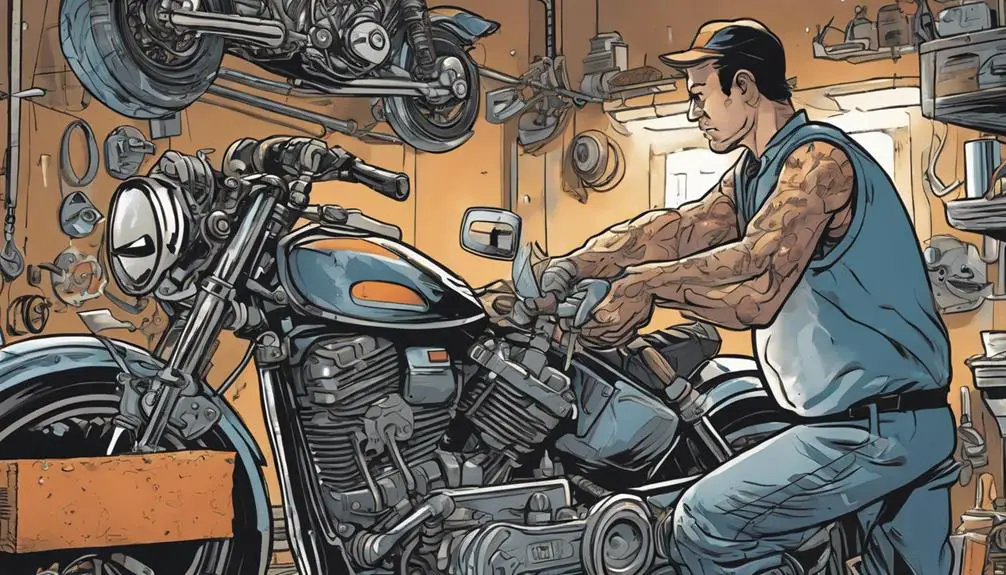
To diagnose motorcycle vibrations effectively, you need to recognize the common causes that can lead to an unsettling ride.
Start by considering your tires; uneven wear or improper pressure can create a bumpy experience. Check your wheel alignment, too—misalignment can throw off your balance and lead to unwanted shaking.
Next, think about your brakes. Worn brake pads or warped rotors mightn't only compromise safety but also create vibrations when you ride.
Don't forget about your chain and sprockets; a loose or damaged chain can cause a jolting sensation as you accelerate or decelerate.
Suspension issues are another key factor. If your forks or shocks are worn, they won't absorb bumps effectively, leading to a rough ride.
Inspect Engine Mounts
Checking your engine mounts is fundamental, as worn or damaged mounts can contribute considerably to unwanted vibrations while riding.
These mounts are essential for securing your engine and absorbing vibrations that could otherwise shake your bike apart. Start by visually inspecting them for cracks, rust, or any signs of wear. Look for loose bolts or any movement in the mounts when you apply pressure; they should remain secure and stable.
If you notice any irregularities, it's time to replace them. Don't hesitate to consult your motorcycle's manual for specific torque specs and replacement procedures. Using high-quality replacements can make a significant difference in how smoothly your ride feels.
Remember, the freedom of the open road is yours to seize, but it's critical to verify your bike's components are up to the task.
After checking your mounts, take a moment to feel the difference. A smooth-running engine can transform your riding experience, allowing you to focus on the exhilaration of the ride rather than the vibrations beneath you.
Embrace the journey ahead with confidence, knowing you've taken the necessary steps to enhance your motorcycle's performance.
Check Wheel Alignment
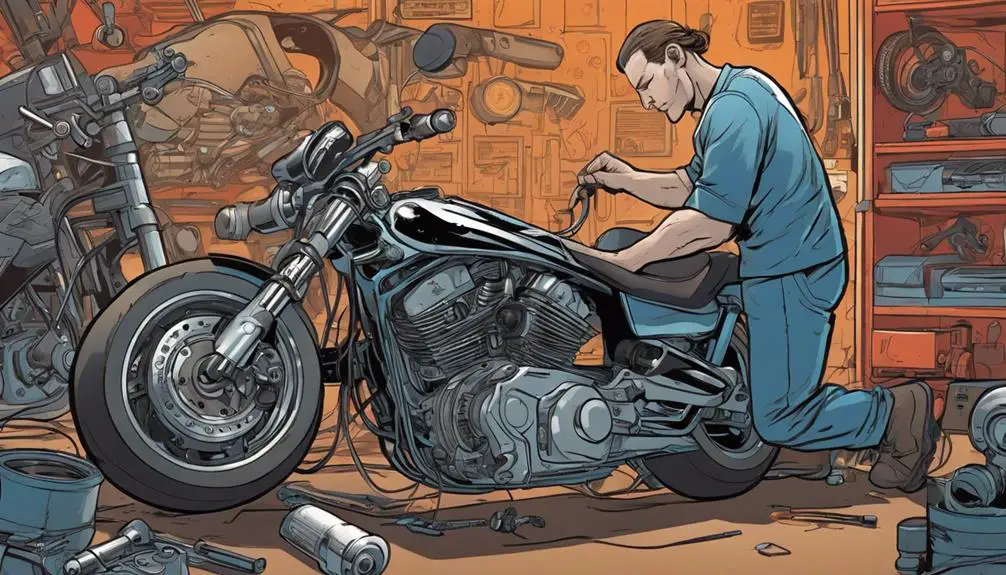
Ensuring your wheel alignment is spot on is essential for a smooth and stable ride. When your wheels are aligned correctly, you'll feel in control, gliding down the road with confidence. Misalignment can lead to uneven tire wear, handling issues, and unwanted vibrations that can spoil your freedom on two wheels.
To check your alignment, start by inspecting the rear wheel's position relative to the front. Use a straight edge or a measuring tape to determine if both wheels are parallel. If they're not, it's time to make adjustments. Most motorcycles have alignment marks on the swingarm for reference, so use those to guide your adjustments.
Next, loosen the axle nut and adjust the alignment using the adjusters on the swingarm. After making your adjustments, tighten everything back up and double-check your measurements. A quick test ride can help you feel if the alignment is correct—notice how the bike handles and whether the vibrations have eased.
Examine Tire Condition
When you experience vibrations on your motorcycle, checking the tire condition should be your next step.
Inspect the tread depth to guarantee it's adequate for safe riding and look for any signs of damage that could affect performance.
Addressing these issues can help you maintain a smoother ride and prevent further problems down the line.
Inspect Tire Tread Depth
Regularly inspecting your motorcycle's tire tread depth is crucial for maintaining ideal performance and safety on the road. Worn tires can compromise your grip, leading to vibrations and a diminished riding experience.
To guarantee your freedom on two wheels, grab a tread depth gauge or simply use the penny test. Insert a penny into the tread; if you can see the top of Lincoln's head, it's time for new tires.
Pay attention to uneven wear patterns, as they can signal alignment issues or improper inflation. Consistent tread depth across the tire indicates balanced performance, fundamental for those exhilarating rides.
Don't forget to check both the front and rear tires, as they can wear differently. Maintaining proper tread depth not only enhances traction but also improves handling in various conditions, from rain-slicked roads to winding curves.
Embrace the open road with confidence by making tire inspections a regular part of your routine. A quick check can save you from potential hazards and keep your motorcycle running smoothly.
After all, the ride is all about feeling alive—so verify your tires are up to the challenge!
Check for Tire Damage
After checking tire tread depth, you should also inspect your tires for any visible damage that could affect your ride. Riding with damaged tires can lead to dangerous vibrations and compromise your freedom on the road.
Here's what to look for:
- Bulges or Blisters: Check for any irregularities on the tire surface. These can indicate structural weakness.
- Cuts or Gashes: Look for deep cuts that could expose the tire's inner layers. Even small cuts can grow and lead to flats.
- Cracks: Inspect the sidewalls for cracks. These can weaken the tire and increase the risk of blowouts.
- Uneven Wear: Notice any patches of uneven wear. This might suggest alignment issues or suspension problems, affecting your ride quality.
Taking a few moments to evaluate your tires can prevent larger issues down the road. You owe it to yourself and your bike to verify everything's in prime condition.
Assess Suspension Components
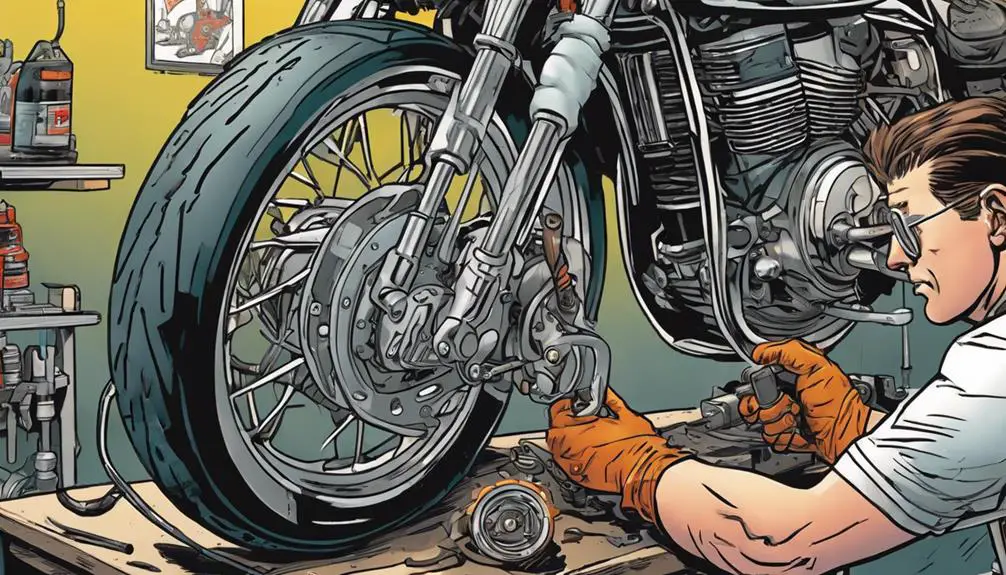
To effectively diagnose motorcycle vibrations, you should closely examine the suspension components for signs of wear or damage.
Start by checking the forks and shock absorbers. Look for any leaks, dents, or unusual wear patterns. If you notice oil seeping from the seals, it's a clear sign that the seals need replacing. Damaged forks can lead to improper alignment, resulting in vibrations that disrupt your ride.
Next, assess the bushings and bearings in the suspension linkage. Worn-out bushings can create play in the suspension system, which often translates into unwanted vibrations. Grab your tools and give everything a good wiggle; if it feels loose, it likely needs attention.
Don't forget to inspect the swingarm. Look for cracks or signs of fatigue, as these can severely affect handling and contribute to vibrations.
Review Chain and Sprockets
When you're diagnosing motorcycle vibrations, don't overlook the chain and sprockets.
Check the chain tension, inspect for sprocket wear, and make sure to lubricate regularly.
These steps are essential for smooth performance and can help you pinpoint any issues.
Inspect Chain Tension
Inspecting chain tension is essential for guaranteeing smooth operation and minimizing vibration in your motorcycle. A loose or overly tight chain can lead to an uncomfortable ride and potential damage. To keep your ride liberating and free from vibrations, follow these steps to check your chain tension:
- Position Your Motorcycle: Confirm your bike is upright and on a level surface. This provides an accurate reading.
- Locate the Chain: Examine the chain's slack by pushing down on the chain midway between the sprockets.
- Measure the Slack: The ideal slack varies by model, but it generally should be around 1 to 2 inches. Refer to your owner's manual for specific guidelines.
- Adjust as Necessary: If the tension isn't within the recommended range, adjust it using the rear axle adjusters. Remember to keep both sides even.
Regularly inspecting your chain tension not only improves your bike's performance but also enhances your riding experience.
Stay aware and in tune with your machine to ride freely!
Check Sprocket Wear
Check for sprocket wear regularly to confirm your motorcycle's chain and sprockets work together effectively and minimize vibrations. Worn sprockets can lead to a poor fit with the chain, causing extra stress and unwanted vibrations.
Start by visually inspecting the sprockets for signs of wear, such as hooked teeth or uneven surfaces. If you notice these issues, it's time to take action.
Use a caliper or ruler to measure the tooth depth against the manufacturer's specifications. If the teeth appear excessively worn or shallow, replace them. Remember, even if your chain looks fine, a compromised sprocket can still create havoc during your rides.
Next, check the alignment of the sprockets. Improper alignment can cause premature wear and excessive vibrations. Adjust them as needed to confirm everything lines up perfectly.
Don't forget to inspect the chain itself, as it works hand in hand with the sprockets. A well-maintained chain and sprocket system keeps your ride smooth and enjoyable.
Lubricate Regularly
After ensuring your sprockets are in good shape, regularly lubricating your chain is essential for maintaining peak performance and reducing vibrations. A well-lubricated chain not only enhances your bike's efficiency but also prolongs the life of your components.
Here's how you can keep your chain in top condition:
- Choose the Right Lubricant: Select a quality chain lubricant suitable for your motorcycle type, whether it's wet or dry conditions.
- Clean the Chain First: Before applying lubricant, clean your chain to remove dirt and grime. A dirty chain can lead to increased wear and vibrations.
- Apply Evenly: Spray or apply the lubricant evenly along the chain while rotating the wheel. Make sure it reaches all links.
- Wipe Off Excess: After lubrication, wipe off any excess to prevent attracting dirt, which can cause more wear.
Embrace the freedom of the open road by ensuring your motorcycle runs smoothly. Regular chain maintenance is a vital step to experiencing the ride without unnecessary vibrations.
Keep your bike happy, and it'll keep you free!
Analyze Exhaust System
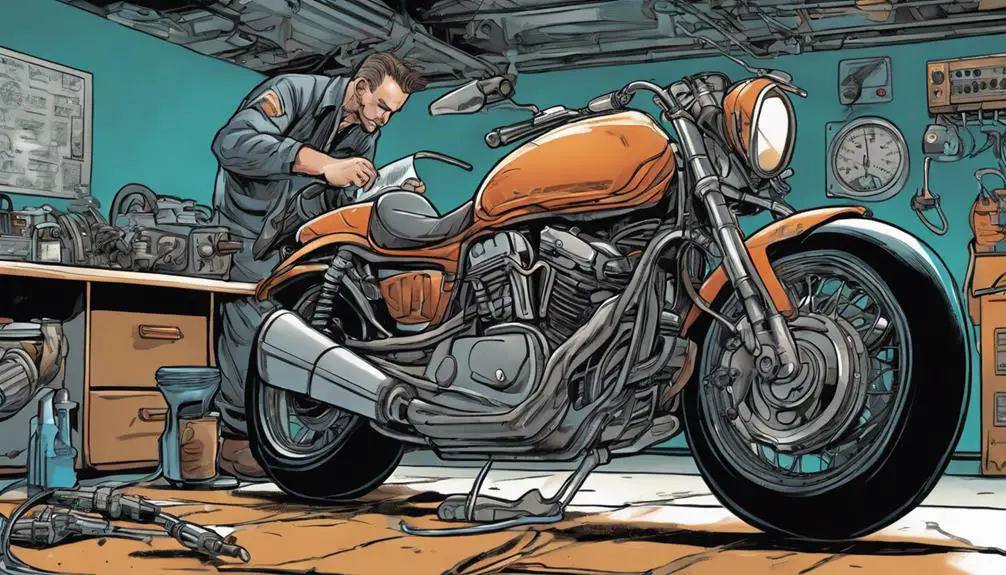
Regularly analyzing your motorcycle's exhaust system can help identify issues that may contribute to unwanted vibrations. Start by checking for loose connections or damaged hangers that could allow the exhaust to move excessively. A secure exhaust system minimizes vibrations and enhances your ride's freedom.
Next, inspect the exhaust pipes for cracks or leaks. Even small leaks can alter back pressure, causing your engine to run unevenly and create vibrations. Use your hands to feel for escaping gases while the engine runs. If you notice any changes in sound or feel, it's time to address those leaks.
Don't forget to listen for unusual noises while riding. A throaty roar or excessive rumble might indicate an exhaust issue that needs attention.
Also, consider the heat shields—make sure they're intact. Damaged heat shields can vibrate against the pipes, adding to the unwanted noise and feel.
Evaluate Brake Components
Examining your brake components is just as important as guaranteeing your exhaust system is in good shape, as worn or damaged brakes can lead to vibrations that affect your ride quality and safety.
You want to feel free on the road, not held back by faulty brakes. Here's a quick checklist to guide you through evaluating your brake components:
- Inspect Brake Pads: Check for wear and tear. Worn pads can create uneven pressure and lead to vibrations.
- Examine Rotors: Look for warping or uneven surfaces. Any irregularities can cause shaking during braking.
- Check Brake Lines: Ensure they're free from leaks and damage. Compromised lines can affect brake performance and introduce vibrations.
- Test Brake Calipers: Make sure they're functioning properly. Sticking calipers can lead to uneven braking force, resulting in vibrations.
Test Engine Performance
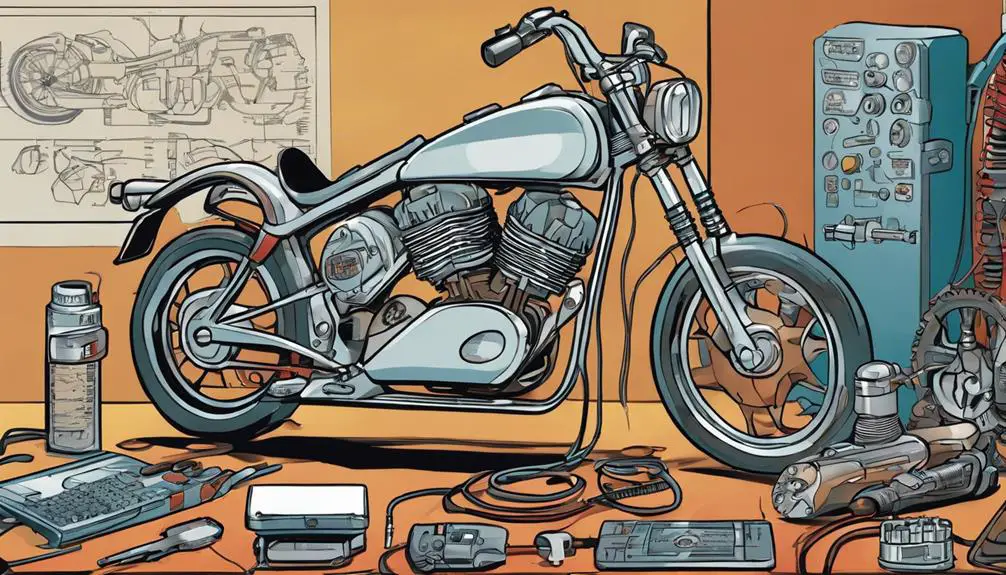
Testing your engine performance is essential, as any issues can lead to vibrations that disrupt your ride and overall enjoyment.
Begin by checking the engine's idle speed; a fluctuating idle can signal deeper problems. If your engine purrs like a lion but still vibrates, inspect the throttle response. You want smooth acceleration without hesitation or stuttering.
Next, listen closely while riding. Unusual noises, especially knocking or pinging, can indicate engine trouble. These sounds often accompany unwanted vibrations. Additionally, pay attention to how your bike feels at various RPMs. If the vibrations intensify at specific speeds, it might point to an imbalance in the engine.
Don't forget to examine your fuel system. A clogged filter or injectors can disrupt performance, leading to those pesky shakes.
As you ride, monitor your engine temperature. Overheating can create significant vibrations, and nobody wants to be stranded on the road.
Seek Professional Help
When you're facing persistent vibration issues, knowing when to seek professional help can save you time and money.
Consider the expertise required for your specific problem, weigh the cost against the value of a proper diagnosis, and think about the right timing for consulting a mechanic.
Making the decision to involve a professional can lead to a quicker resolution and a smoother ride.
Identify Expertise Required
Often, it's wise to consult a professional mechanic if you're unsure about diagnosing or fixing motorcycle vibrations. Seeking expert help guarantees that you don't overlook critical issues that could impact your safety and ride quality.
Here are four key reasons to reflect on professional assistance:
- Experience: Mechanics have hands-on experience with various motorcycle models and can quickly identify vibration sources that may stump you.
- Specialized Tools: Professionals use advanced diagnostic tools that can pinpoint problems more accurately than standard equipment.
- Comprehensive Knowledge: They understand the intricacies of motorcycle mechanics, including how different components interact and can affect vibrations.
- Safety Assurance: A trained mechanic can guarantee your bike is safe to ride, addressing any underlying issues that could lead to more significant problems down the road.
Consulting a professional not only saves you time and potential frustration but also empowers you. By allowing experts to handle complex issues, you free yourself to enjoy the ride.
Embrace the liberation of knowing your motorcycle is in capable hands, and ride confidently!
Cost Vs. Value
While professional help may seem like an added expense, the value it brings regarding safety and peace of mind far outweighs the cost. When you ride, you're not just seeking freedom; you're embracing a lifestyle that requires your motorcycle to perform flawlessly. A vibration issue could signify serious mechanical problems that, if ignored, might lead to costly repairs or even accidents.
Investing in a professional diagnosis isn't just about fixing a problem; it's about ensuring your motorcycle operates at its best, allowing you to experience the open road with confidence. Skilled mechanics possess the knowledge and experience to identify issues you might overlook, saving you from potential dangers.
Think of it as an investment in your freedom. The cost of a professional consultation is minor compared to the potential expenses of accidents, injuries, or extensive repairs. Plus, the peace of mind that comes from knowing your bike is safe can't be measured in dollars and cents.
Embrace the liberation of the ride, knowing you've taken the right steps to protect yourself and your motorcycle. Let the experts handle the complexities, so you can focus on enjoying the journey.
Timing for Consultation
Recognizing the right moment to seek professional help is essential for maintaining your motorcycle's performance and safety. Ignoring signs of vibration can lead to serious issues down the road, so it's vital to be proactive.
Here are four key indicators that it's time to consult a professional:
- Persistent Vibration: If you notice ongoing vibration that doesn't improve, it's a red flag.
- Unusual Noises: Strange sounds accompanying vibrations can signal deeper mechanical problems that require expert diagnosis.
- Handling Issues: Difficulty controlling your bike or feeling unstable while riding indicates it's time for a check-up.
- Physical Inspection: If you've inspected your motorcycle and can't pinpoint the cause of the vibration, don't hesitate to reach out to a specialist.
Embracing the freedom of the open road means ensuring your motorcycle is in top shape. Don't let hesitation hold you back—seeking help when needed is a vital step towards liberation and a smoother ride.
Trust the professionals to keep your motorcycle performing at its best, allowing you to enjoy every twist and turn without worry.
Frequently Asked Questions
How Can I Prevent Future Motorcycle Vibrations?
To prevent future motorcycle vibrations, you'll want to keep your bike well-maintained.
Regularly check the tires for proper inflation and wear, as uneven tires can cause vibrations.
Make certain your suspension is adjusted correctly and inspect the frame for loose components.
Don't forget to tighten bolts and fasteners, as loose parts can amplify vibrations.
Finally, consider upgrading to higher-quality parts designed to reduce vibration.
Your ride should be smooth and enjoyable!
What Tools Do I Need for Vibration Diagnosis?
To diagnose motorcycle vibrations, you'll need a few essential tools.
Grab a reliable multimeter to check electrical components and a mechanic's stethoscope to pinpoint noise sources.
A torque wrench helps guarantee all bolts are properly tightened.
Don't forget a vibration analyzer, which can provide detailed insights into frequency and amplitude.
With these tools, you can uncover the root causes of vibrations and liberate your ride from unwanted disturbances!
Is Vibration Normal for All Motorcycles?
Vibrations vary vastly among motorcycles, so don't panic!
While some level of vibration's normal, particularly at certain speeds, excessive shuddering signals something's amiss. You'll want to pay attention to how your ride feels—if it's too rough, it could mean misaligned parts or worn components.
Embrace the freedom of the open road, but stay alert; your bike's vibrations should enhance, not hinder, your ride!
Keep your machine in harmony for happiness on every journey.
How Often Should I Check for Vibrations?
You should check for vibrations regularly, ideally every time you ride.
Pay attention to how your bike feels during different speeds and conditions. If you notice changes or unusual vibrations, don't ignore them; they could signal underlying issues.
It's all about staying connected with your machine. Regular checks empower you to maintain control and guarantee a safer, more enjoyable ride.
Trust your instincts; your bike will thank you for it!
Can Vibration Affect My Motorcycle's Fuel Efficiency?
Yes, vibrations can definitely affect your motorcycle's fuel efficiency.
When your bike vibrates excessively, it can lead to inefficient engine performance, causing it to consume more fuel. You might notice that rough rides result in less power and increased throttle input, which drains your tank faster.
Conclusion
So, as you rev up your motorcycle, be sure to check those vibrations—after all, who doesn't love a good unexpected jolt?
Ignoring your bike's quirks is a surefire way to keep your ride exciting!
Just remember, a little maintenance goes a long way to avoid transforming your smooth cruise into a wild rodeo ride.
If you skip these tips, you might find yourself becoming best friends with your mechanic.
Happy riding!